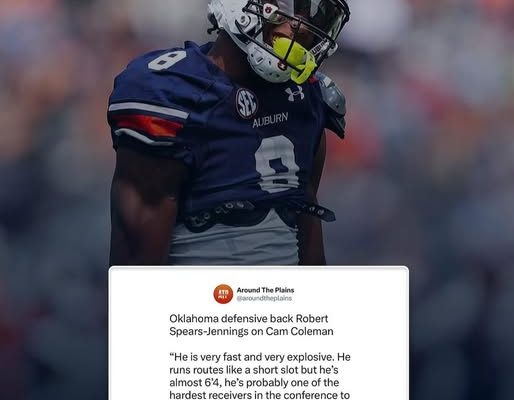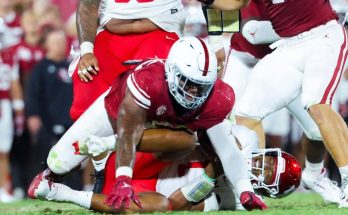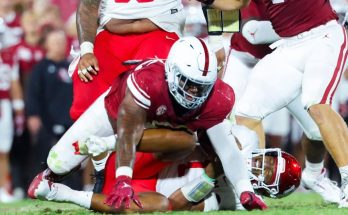The gridiron is a stage where narratives unfold, and every snap, every play, contributes to the sprawling saga of collegiate football. Within this ever-evolving tapestry, individual matchups often spark the most compelling discussions, illuminating the intricate dance between offensive prowess and defensive resolve. One such recent, albeit subtly etched, narrative revolves around the electrifying presence of Auburn’s wide receiver, Cam Coleman, and the silent, yet undeniably impactful, interactions he’s had with the defensive backs of the Oklahoma Sooners. While explicit soundbites from an Oklahoma defensive back directly dissecting Coleman’s game remain elusive in the public discourse, the very nature of their on-field encounters, combined with the broader context of both programs, paints a vivid picture of the respect and challenge that players of Coleman’s caliber command.
Cam Coleman, a name that reverberates with a distinct hum of anticipation throughout the college football landscape, arrived in Auburn with the kind of five-star pedigree that instantly elevates expectations. His freshman season was, in many regards, a testament to that hype. He showcased flashes of brilliance, moments that made even the most seasoned defensive coordinators take note. As the season progressed, particularly in its latter stages, Coleman truly began to blossom, transforming from a promising newcomer into a legitimate threat capable of altering the complexion of a game with a single, spectacular catch. His uncanny ability to high-point the ball, his deceptive speed for a player of his imposing size, and his innate understanding of how to create separation, even against seasoned defensive backs, marked him as a truly special talent.
The evolution of Coleman’s game, especially his remarkable production in the final three contests of his inaugural collegiate campaign, underscored his burgeoning potential. During this critical stretch, he consistently demonstrated an elevated level of performance, hauling in a significant portion of his season’s catches and touchdowns. This late-season surge wasn’t merely a statistical anomaly; it was a clear indication that Coleman was adjusting to the speed and physicality of SEC play, internalizing the nuances of route running, and developing a profound chemistry with his quarterbacks. For any defensive back tasked with covering him, this meant an entirely new level of scrutiny and preparation. The film study would reveal a player who was not only physically gifted but also rapidly developing the mental acumen to exploit defensive weaknesses.
The Oklahoma Sooners, a program steeped in defensive tradition and known for producing elite secondary talent, found themselves facing Coleman in a significant matchup. While a direct quote from an Oklahoma defensive back might not have made headlines, the visual evidence from that game speaks volumes. A particular image, capturing Oklahoma safety Peyton Bowen in the act of tackling Cam Coleman, encapsulates the essence of this high-stakes confrontation. This single snapshot, devoid of words, conveys the relentless effort and strategic precision required to contain a player of Coleman’s dynamic capabilities. It represents the silent communication that occurs on the field – the acknowledgment of a formidable opponent and the sheer will to bring him down. For defensive coordinators, preparing for an athlete like Coleman involves more than just schemes; it requires instilling in their defensive backs a heightened sense of awareness, discipline, and an unwavering commitment to fundamental tackling. Every step, every jam at the line of scrimmage, and every break on the ball becomes critical when facing a wide receiver who can turn a seemingly ordinary play into a highlight-reel touchdown.
Furthermore, the Oklahoma-Auburn connection extends beyond just a single game, notably through the presence of Jackson Arnold. Arnold, a former five-star quarterback recruit who began his collegiate journey with the Sooners before transferring to Auburn, now finds himself in a position to deliver the ball to Coleman. This connection adds another layer of intrigue to the dynamic. Arnold’s familiarity with the Oklahoma defensive schemes, even if from the offensive side, could, in theory, provide a subtle advantage for Auburn’s offense when facing his former team in future matchups. Conversely, the Oklahoma defensive players, having practiced against Arnold, would understand his tendencies and strengths, which could inform their strategy against an Auburn offense now led by him and featuring a primary weapon like Coleman. The synergy between a talented quarterback and an elite wide receiver is often the catalyst for offensive fireworks, and the pairing of Arnold and Coleman has the potential to be truly explosive. Defensive backs, therefore, must not only contend with Coleman’s individual skill set but also anticipate the precise timing and ball placement that Arnold can deliver, making their job exponentially more challenging.
The broader landscape of college football consistently spotlights the cat-and-mouse game between elite wide receivers and top-tier defensive backs. Players like Cam Coleman represent the vanguard of offensive evolution – athletes who combine athleticism, size, and refined technique to create mismatches across the field. For defensive backs, the challenge is immense. They must possess a diverse skill set that includes exceptional man-to-man coverage ability, keen zone awareness, disciplined eye control, and robust tackling form. The margin for error is razor-thin. A single misstep, a momentary lapse in concentration, can result in a big play.
The preparation for containing a receiver of Coleman’s ilk is multifaceted and begins long before game day. It involves extensive film study, analyzing tendencies, identifying preferred routes, and understanding how offensive coordinators aim to isolate him against specific defenders. Defensive backs and their coaches meticulously break down every aspect of his game – from his release off the line of scrimmage to his ability to adjust to poorly thrown balls. Drills in practice are designed to simulate the kind of contested catch situations he thrives in, forcing defensive backs to refine their ball skills and their ability to play through the receiver’s hands. Communication within the secondary is paramount, with safeties and cornerbacks constantly adjusting their coverage based on pre-snap reads and in-play developments. They must be able to recognize formations, anticipate route combinations, and react decisively to prevent Coleman from gaining significant yardage.
The physical demands placed on defensive backs in these matchups are equally rigorous. They must be able to run stride-for-stride with Coleman, possessing the closing speed to break up passes and the strength to shed blocks and make tackles in the open field. The mental fortitude required is perhaps even greater. Covering an elite receiver is a constant test of resilience. There will be plays where Coleman makes an incredible catch, even with tight coverage. A defensive back must possess the mental toughness to shake off such moments, reset, and focus on the next snap. They cannot allow one successful play by the offense to dictate the remainder of their performance. The ability to maintain composure under pressure, to trust their technique, and to remain confident in their abilities is crucial for sustained success.
While the specific comments from an Oklahoma DB about Cam Coleman may not be publicly available, the collective understanding within the defensive community regarding players of Coleman’s talent is universal. Coaches and players alike recognize the immense challenge he presents. The focus shifts from individual praise or criticism to a strategic assessment of how to mitigate his impact. The game against Oklahoma, and particularly the visual of Bowen’s tackle, serves as a tangible example of the intense individual battles that define college football at its highest level. It highlights the non-verbal dialogue that occurs between two elite athletes competing fiercely within the lines.
Looking ahead, the narrative surrounding Cam Coleman and the defenses he will face will only continue to grow. As he matures and refines his craft, his ability to affect games will become even more pronounced. For defensive backs across the SEC and beyond, he represents a measuring stick – a formidable opponent against whom their skills and preparation will be rigorously tested. The pursuit of containing players like Coleman drives innovation in defensive schemes and fuels the relentless pursuit of individual excellence in the secondary. Every Oklahoma defensive back, whether they articulate it publicly or not, will understand the magnitude of the task when Cam Coleman lines up across from them. It’s a silent nod to a truly exceptional talent, a recognition of the dynamic threat he poses, and a testament to the ongoing evolution of offensive and defensive strategies in the ever-competitive world of college football. The absence of a specific quote does not diminish the mutual respect, nor does it lessen the inherent challenge that such a matchup presents. Instead, it underscores the intensity of the competition that plays out in every snap, where actions on the field speak far louder than any words could.



